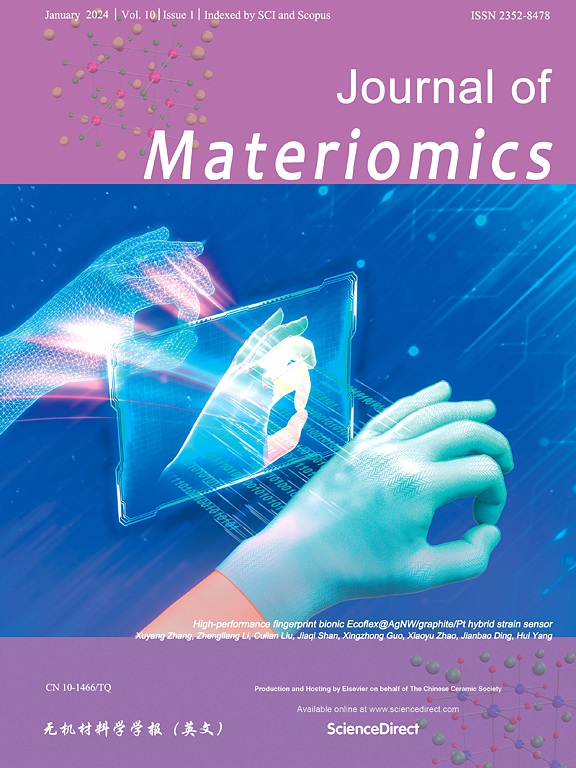原子缺陷抑制原始p型Bi0.3Sb1.7Te3作为发电和冷却的高性能热电材料
IF 9.6
1区 材料科学
Q1 CHEMISTRY, PHYSICAL
引用次数: 0
摘要
高强度高性能的p型(Bi,Sb)2Te3是近室温热电转换的关键材料,可靠的合成和制造已成为当务之急。已知高温合成的反位SbTe‘和空位vSb’受体缺陷的能量有利形成导致电和声子输运的额外载流子和散射中心。然而,具有最小晶格缺陷的p型(Bi,Sb)2Te3如何发挥作用仍有待进一步研究。在此,我们通过简单的机械合金化结合火花等离子烧结(SPS)工艺,提出了晶体缺陷抑制原始(Bi,Sb)2Te3的机械鲁棒性和热电性能的协同增强。SbTe‘和vSb’'受体缺陷得到有效抑制,导致载流子迁移率显著提高。带隙略微扩大到0.24 eV,增强了原始Bi0.3Sb1.7Te3在宽温度范围内的热电性能,在300-473 K范围内zT300 K为1.16,zTave为1.21。有趣的是,具有均匀分散纳米孔的SPS过程中受限的原位晶粒粗化容易使其具有206mpa的超高抗压强度,超过了目前报道的(Bi,Sb)2Te3的抗压强度。制作了一个7对模块(与n-Bi2Te3耦合),在Thot = 300 K时显示出超过70 K的竞争性ΔT。此外,与n-Mg3SbBi耦合的发电模块在250 K温度梯度下的热电转换效率达到了9.5%。该策略消除了原始(Bi,Sb)2Te3的复杂加工和外部掺杂的需要,在热电发电和冷却应用中显示出巨大的潜力。本文章由计算机程序翻译,如有差异,请以英文原文为准。


Atomic-defect-suppressed pristine p-type Bi0.3Sb1.7Te3 as robust high-performance thermoelectrics for power generation and cooling
High-strength high-performance p-type (Bi,Sb)2Te3 are of pivotal importance for near-room-temperature thermoelectric conversions, the reliable synthesis and fabrication has been viewed of imperative priority. It is known that the energy-favorable formation of anti-site SbTe’ and vacancy vSb''' acceptor defects from high-temperature syntheses results in additional charge carriers and scattering centers for electrical and phonon transport. However, how p-type (Bi,Sb)2Te3 with minimal lattice defects function remains to be scrutinized. Herein, we present the synergistic enhancements of mechanical robustness and thermoelectric property in crystallographic-defect-suppressed pristine (Bi,Sb)2Te3 through a simple mechanical alloying combined with spark-plasma-sintering (SPS) process. The SbTe’ and vSb''' acceptor defects were efficiently restrained, contributing to markedly increased charge carrier mobilities. A slightly enlarged band gap of 0.24 eV underpinned enhanced thermoelectric performance for pristine Bi0.3Sb1.7Te3 over a wide temperature range, delivering high zT300 K of 1.16 and zTave of 1.21 over 300–473 K. Interestingly, the confined in-situ grain coarsening during SPS with uniform dispersive nanopores readily endowed an ultra-high compressive strength of 206 MPa, surpassing that of reported (Bi,Sb)2Te3 so far. A 7-pair module (coupled with n-Bi2Te3) was fabricated, demonstrating a competitive ΔT over 70 K at Thot = 300 K. Furthermore, a power-generation module coupled with n-Mg3SbBi registered a cutting-edge thermoelectric conversion efficiency of 9.5% at a temperature gradient of 250 K. The strategy eliminates the need of complex processing nor extrinsic doping for pristine (Bi,Sb)2Te3, demonstrating great potentials in thermoelectric power generation and cooling applications.
求助全文
通过发布文献求助,成功后即可免费获取论文全文。
去求助
来源期刊

Journal of Materiomics
Materials Science-Metals and Alloys
CiteScore
14.30
自引率
6.40%
发文量
331
审稿时长
37 days
期刊介绍:
The Journal of Materiomics is a peer-reviewed open-access journal that aims to serve as a forum for the continuous dissemination of research within the field of materials science. It particularly emphasizes systematic studies on the relationships between composition, processing, structure, property, and performance of advanced materials. The journal is supported by the Chinese Ceramic Society and is indexed in SCIE and Scopus. It is commonly referred to as J Materiomics.
 求助内容:
求助内容: 应助结果提醒方式:
应助结果提醒方式:


